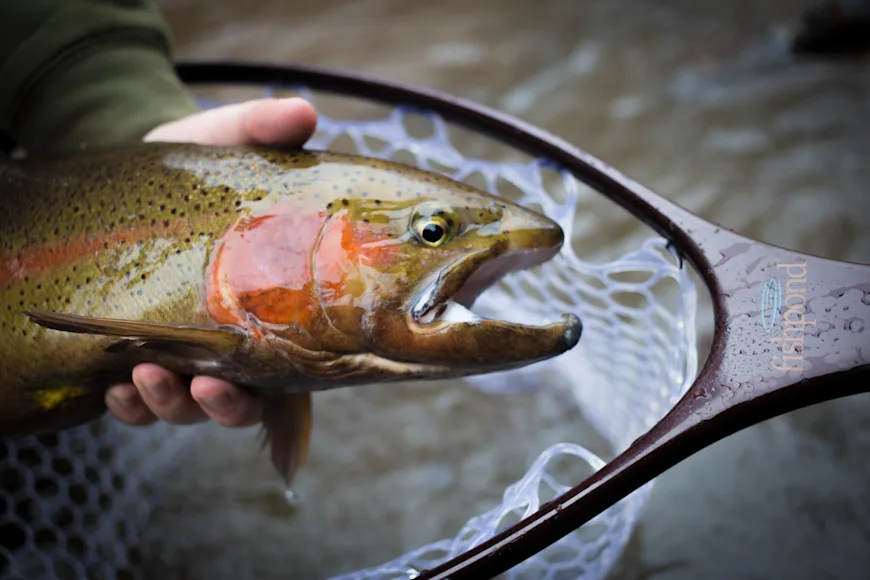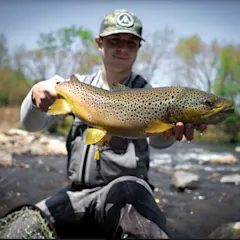_We may earn revenue from the products available on this page and participate in affiliate programs. Learn more ›
_
Best Carbon Fiber Net
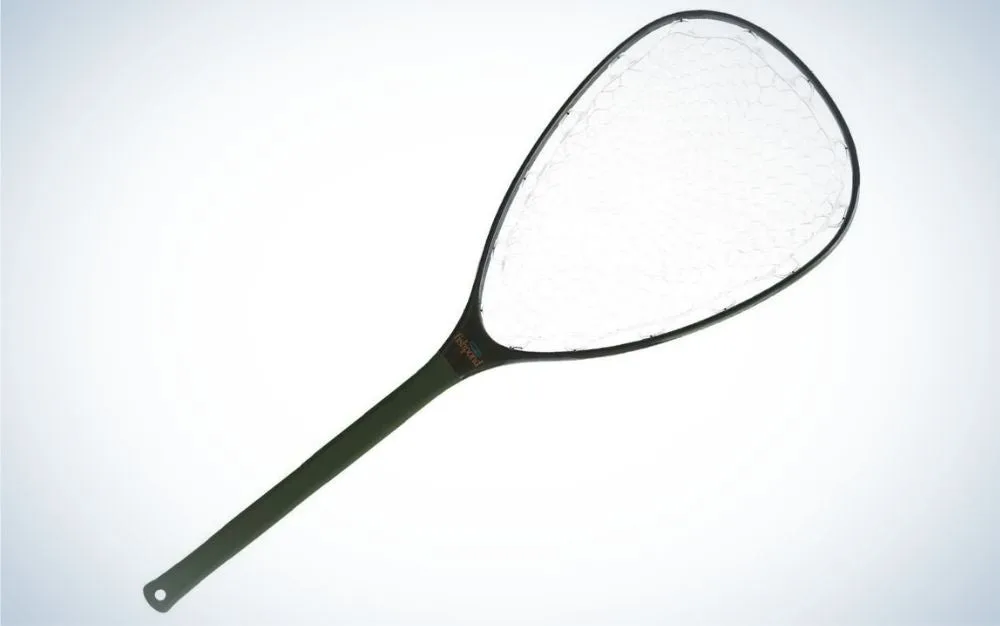
Fishpond Nomad Mid-Length Net
LEARN MORE
Summary
The carbon fiber construction gives anglers the lightweight feel of a single-handed net with the added reach of a long-handled net.
Best Long Handle Net
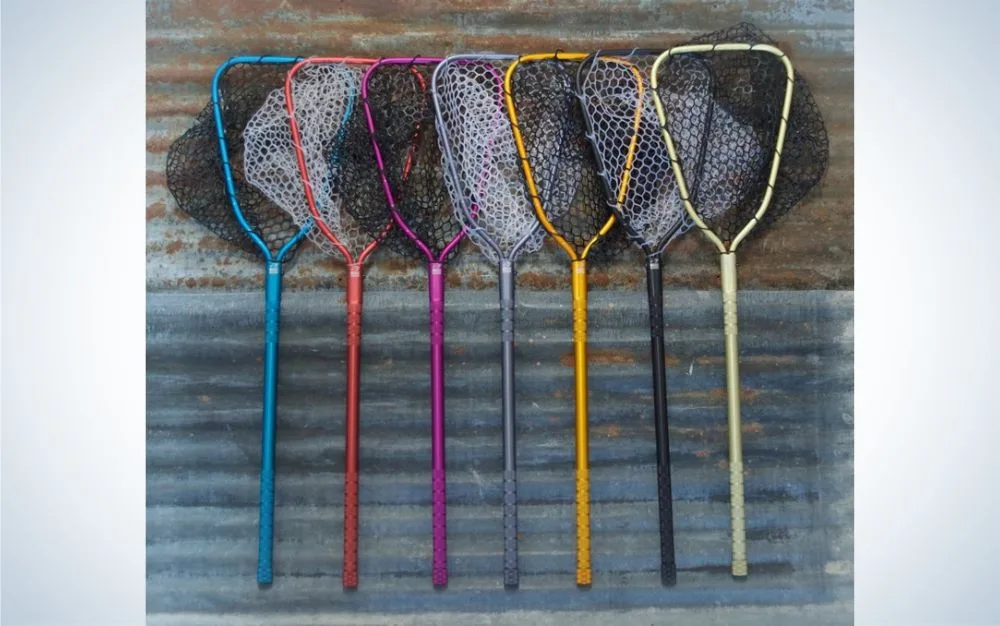
Rising Brookie XL
LEARN MORE
Summary
A bulletproof aluminum net, the Rising’s Brookie XL pairs an extra-long handle with a perfectly sized hoop for trout fishing.
Best Cradle Net

Frabill Musky Cradle
LEARN MORE
Summary
Cradle-style nets are the best choice to keep big fish in the water and make sure they are released with minimal stress.
Fly fishing nets have been around since the beginning of the sport. They are necessary when dealing with sporadic fish, tricky currents, and long fly rods. Fly fishing without a net can mean difficulty landing fish, lost fish, and broken gear. Modern materials and revolutionary designs resulted in nets for any scenario. There are long-handled nets, lightweight travel nets, and even cradle nets to minimize stress on fish. I look for durable nets that are appropriately sized for the fish I’m after and have features that allow for a safe release. These are the best fly fishing nets for any situation fly anglers will find themselves in.
Best Carbon Fiber Net: Fishpond Nomad Mid-Length Net
Best Long Handle Net: Rising Brookie XL
Best Cradle Net: Frabill Musky Cradle
Best Rubber Net: Broken Twig Full Strength Landing Net
Best Wading Net: Frabill Floating Trout Net
Best Wooden Net (Sustainability Pick): Brodin Phantom Cutthroat Landing Net
Things to Consider Before Buying
While we all want to put our money towards flashy reels or the newest rods on the market, setting a little aside for a quality net is well worth it. Any landing net is better than none, but tailoring a net to your fishing style is crucial for success. I evaluate my needs based on my style of fishing, the type of water, and who I am fishing with. Once I know these factors, I consider the length and materials to find the ideal net.
Fishing Style
Fly fishing has evolved into countless techniques and styles. While there is plenty of overlap, certain techniques, like spey fishing, benefit from specific nets. Spey fishing typically involves rods 11 feet and up, and large powerful fish. To deal with the extra-long rod, a long-handled net allows you to net the fish further away to avoid snapping the rod. Also, consider what gear you use. Anglers who fish with a vest typically lean towards shorter handled nets. These can clip to a net release off the back of the vest for easy access. Those fishing sling packs or backpacks may prefer a long-handled net that loops through the pack straps. Lastly, anglers fishing alone may prefer a single-handed net to reduce weight. While anglers fishing in groups can benefit from the added reach of a long-handled net.
Net Materials and Design
Net design has come a long way from the wooden classics. These days high-end machined aluminum, carbon fiber, and fiberglass nets are all common. They reduce weight, increase durability, and improve the net’s lifespan. Net bags are also important for the safety of fish. Trout and salmon are particularly susceptible to improper handling. They rely on a protective slime coat that, when damaged, leaves them vulnerable to infections. Net bags made of rubber or a rubberized coating keep their protective slime layer intact. While you may spend a few extra bucks on a rubber net, it’s worth it in the long run to protect our fisheries.
Best Carbon Fiber Net: Fishpond Nomad Mid-Length Net
Best Carbon Fiber Net

Key Features:
Hoop Size: 13”x18”
Handle Length: 19”
Net Bag Material: Rubber Net Bag
Why It Made the Cut: The carbon fiber construction gives anglers the lightweight feel of a single-handed net with the added reach of a long-handled net.
Pros:
Super lightweight
Durable rubber net bag
Good all-around net size
Cons:
Only certain models have inch markers on the handle
Fishpond revolutionized the fly fishing industry with its introduction of carbon fiber nets and has dominated the market ever since. One issue with long-handled nets is they can be cumbersome when fishing alone. The Nomad only weighs 16 ounces which is light enough to carry all day without issue. I prefer to tuck mine behind a backpack strap, but at this weight, most magnetic net holders will also do the job. The 19-inch handle is a good length for extra reach without getting in the way. Throw on the rubber butt stop Fishpond offers and it doubles as a great wading staff. It has saved me several situations where I overestimated my wading skills and underestimated the current.
Best Long Handle Net: Rising Brookie XL
Best Long Handle Net

Key Features:
Hoop Size: 16”x11.5”
Handle Length: 24”
Net Bag Material: Rubber netting
Why It Made the Cut: A bulletproof aluminum net, the Rising’s Brookie XL pairs an extra-long handle with a perfectly sized hoop for trout fishing.
Pros:
Durable anodized aluminum construction
American made
Unconditional warranty
Handle doubles as a flask
Cons:
The metal handle can be uncomfortably cold during the winter
I started using Rising Nets while fishing for steelhead and salmon on the Great Lakes. My preferred net of choice was the Lunker Net
for its big bag and durable construction. While it was a great net, I found it to be a little oversized for most trout fishing scenarios. Enter the Brookie XL. This is Rising’s answer to a long-handled net with a trout-sized hoop. The net combines the long handle from the Lunker model and the smaller hoop from the single-handed Brookie net. Don’t fret, the net balances extremely well. The head is sized perfectly for trout fishing while significantly cutting down weight. It is built with a flat front to increase the surface area so you have a better chance of landing fish. Like all rubber nets, eventually, you have to replace the bag. Rather than rethreading an entire net bag, simply pull a single bolt and the head comes free to slide on a new bag. The extra reach of the long handle makes a difference when fishing with friends or in fast currents. Oh, and the handle doubles as a flask to properly celebrate after a good day on the river.
Best Cradle Net: Frabill Pro-Tech Musky Cradle
Best Cradle Net

Key Features:
Hoop Size: 15”x60”
Handle Length: 64”
Net Bag Material: Rubber coated mesh netting
Why It Made the Cut: Cradle-style nets are the best choice to keep big fish in the water and make sure they are released with minimal stress.
Pros:
Big enough for any freshwater species
Rubberized mesh is easy on fish
Folds down for easy storage
Cons:
Takes a bit to get used to using
While we like to think every fish we release lives, the unfortunate truth is, that not all do. To maximize survivorship, many have turned to cradles, like the Frabill Pro-Tech Musky Cradle, for bigger fish. Anyone who has landed a big fish in an undersized net has seen them fold in half. A cradle solves this issue by resting the fish lengthwise in the water while you unhook and revive it. While designed for muskies, I find it works great for steelhead and salmon. These delicate fish struggle if mishandled. Steelhead dropped on the banks may swim off fine but most succumb to head injuries several hours later. The beauty of a cradle is that fish are easy to control and release while minimizing injuries. You can even support an exhausted fish in the current while they recover in the oxygenated water. Learning to net a fish in a cradle may take some time, but the benefit for a struggling species, like steelhead, is worth it.
Best Rubber Net: Broken Twig Full Strength Landing Net
Best Rubber Net
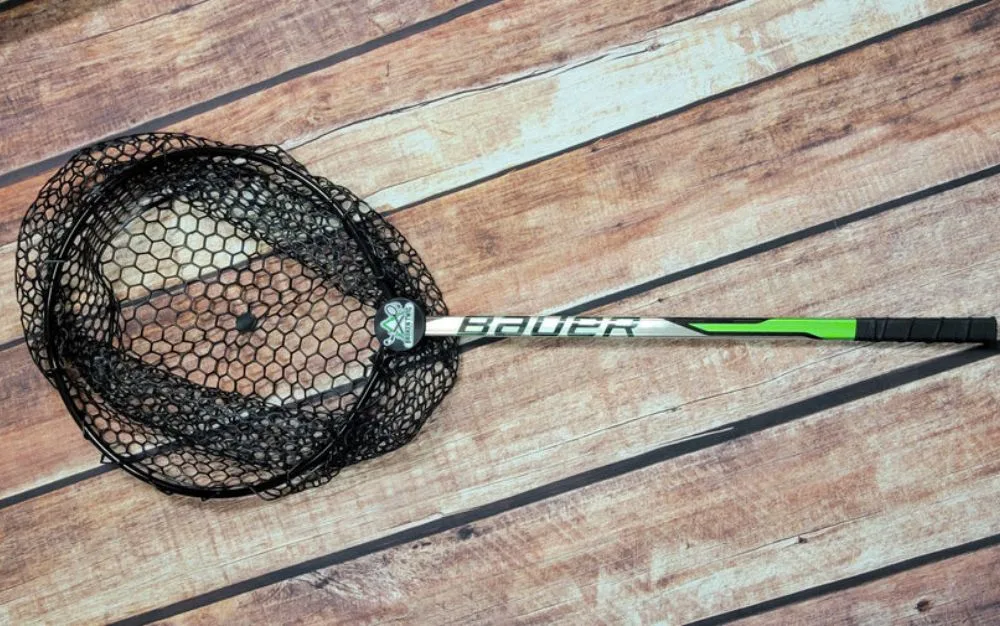
Key Features:
Hoop Size: 19”x18”
Handle Length: 30”
Net Bag Material: Rubber Net Bag
Why It Made the Cut: A unique crossover between hockey and fishing, this net gets the job done when a big fish is on the line
Pros:
Easy to handle
Large net head
Personalized touch
Cons:
Heavier than other nets
I first came across Broken Twigs Landing nets at ICAST 2022. Built from recycled hockey sticks, their nets offer a unique crossover for sports enthusiasts. Make no mistakes, this net is built to perform. The rectangular-shaped handle gives you a firm grip on the net and a nice tape job adds extra grip when wet. As far as rubber nets go, the net frame and bag depth are sized right to tame big fish. At 48 inches end to end, the Full Strength landing net does well in a drift boat or on bigger water. For instance, trout fishing on the Niagara River consists of a three-foot ledge followed by a straight drop-off. When a fish refuses to give in, the extra handle length helps put the fish in the net without endangering yourself.
Best Wading Net: Frabill Floating Trout Net
Best Wading Net
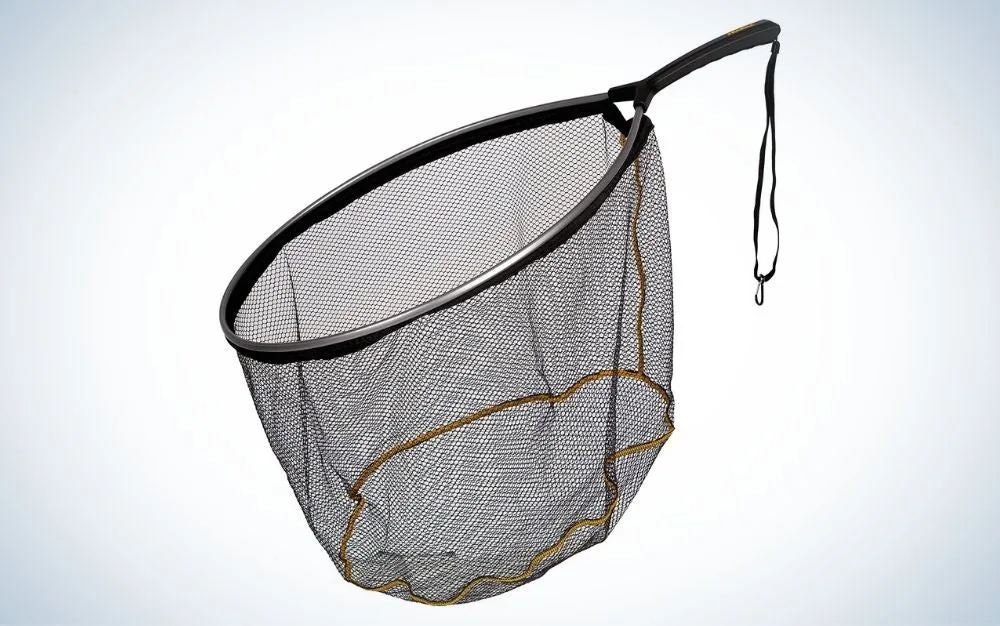
Key Features:
Hoop Size: 19”x25”
Handle Length: 7.5”
Net Bag Material: Rubberized mesh netting
Why It Made the Cut: The ideal balance of size and weight for solo missions or competition fly fishing.
Pros:
Large hoop size
Lightweight
Affordable
Cons:
Can’t replace the net bag if it’s damaged
Derived from competitive fly fishing overseas, euro nymphing captured the attention of the fly fishing industry. With the popularity of euro nymphing came products like the Frabill Floating Trout Net. In euro nymphing, the goal is to catch as many fish as fast as possible. To quickly get fish in the net, anglers prefer small landing nets that hang off a pack or directly in front of them. This 19 by 25-inch frame maximizes the hoop size while staying true to the single-hand design competitive anglers prefer. While available in smaller hoop sizes, I prefer this larger size. It easily scoops smaller fish and has plenty of room if you do hook a big one. For a technique that’s all about streamlining your rod, reel, and flies—a net that does the same is a must.
Best Wooden Net (Sustainability Pick): Brodin Phantom Cutthroat Landing Net
Best Wooden Net (Sustainability Pick)
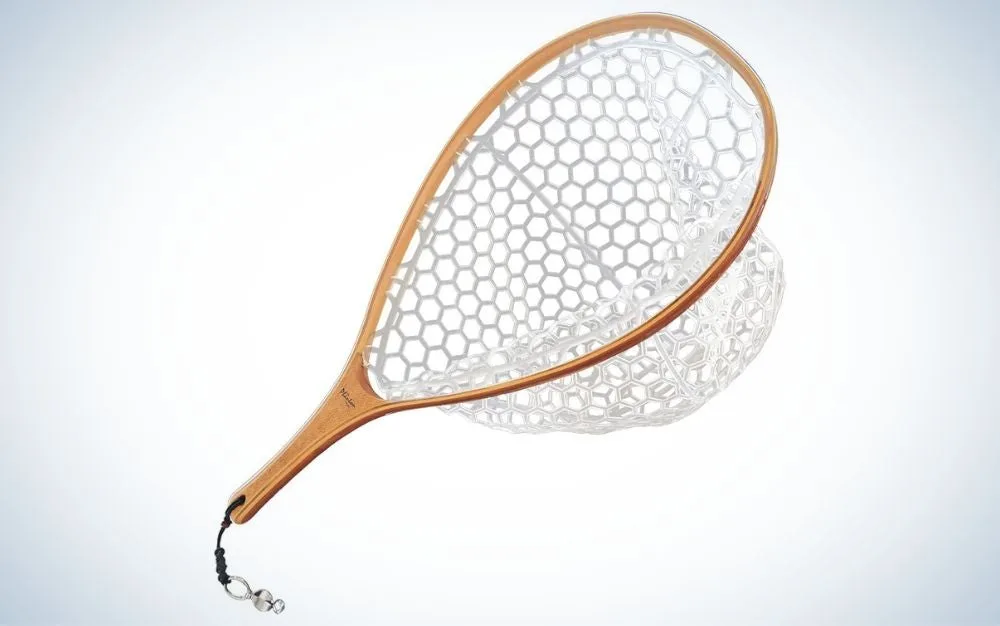
Key Features:
Hoop Size: 10”x15”
Handle Length: 9”
Net Bag Material: Rubber net bag
Why It Made the Cut: An ode to the classics, Brodin combines craftsmanship with a timeless design that works as well as it has for years.
Pros:
Quality materials
Lightweight
Good handle length
Cons:
Not built for fish over 20 inches
Whether you’re a dry fly purist or a sucker for old-school craftsmanship, Brodin has brought wooden nets into the modern era. The Phantom Cutthroat is designed as an all-around trout net capable of handling fish up to 20 inches. These nets are built in a small shop in Costa Rica from sustainably harvested hardwood. The craftsmanship is impressive, making for a lightweight and surprisingly strong net. I keep my net on a magnetic release so it is close by when I hook a fish. In an era where modern materials are always changing, it’s nice to know Brodin’s classic wooden nets hold their own.
How We Made Our Picks
I’ve fished for just about any species with any technique imaginable. Whether swinging flies, euro nymphing, or dry fly fishing, every situation presents a unique set of challenges. Choosing the proper net is a critical part of being successful on the water. I find the best nets are durable, sized properly, and above all, contribute to a healthy release. To ensure the nets lived up to my expectations these are the criteria I based my selections on:
Net Shape: How does the net shape impact its performance?
Handle Length: Does the handle work best for a certain type of fly fishing?
Net Bag Type: What material is the net bag and is it durable?
Durability: Is the net made to withstand the sun, water, and grind of daily use?
Weight: Is the net a good weight to carry all day?
Materials: What materials go into the net and how do they affect performance?
FAQs
Q: Is a net necessary for fly fishing?
To be successful in fly fishing, a net is absolutely essential. Fishing in rivers and streams, the constant current, and slippery bottom make it hard to land a flopping fish without a net. Not only does a net improve your ability to land fish but it’s safer for the fish. Nets allow you to keep fish in the water so they can revive as you unhook them or take a picture.
Q: Where should I put my net when fly fishing?
Depending on the type and size of your net there are several options to store them. For longer-handled nets, I prefer to slip them under my backpack straps until I need them. Other options include sling packs or vests with built-in net holsters. Anglers who prefer a single-handed net typically clip the net to their back to keep it out of the way.
Q: How do I attach or carry a fly-fishing net?
The most common way for anglers to attach a net are magnetic net releases or zingers. A zinger is a metal cable that retracts from a center hub. You can clip it to your waders or vest to have a net ready when you need it. Magnetic net releases work in a similar fashion except one side is clipped to the net and one side to your vest. The tension from the magnet joins the two pieces together until you give it the pull to grab your net.
Q: Are rubber nets better for fish?
I can’t stress enough how important rubber nets or rubberized mesh coatings are for fish. Fish have a protective mucous coating or slime that covers their body. This coating acts as a barrier, fighting off harmful bacteria in the water. Non-rubber nets will scrape off parts of the coating leaving the fish susceptible to infection such as tail rot. Another tip to keep fish healthy is always wet your hands before touching the fish. A dry hand can do just as much damage as the wrong net.
Final Thoughts
Every angler should have a good net. When you put in all the effort to hook a fish, being ready to land it only makes sense. Depending on your preferred style of fly fishing, some nets may be better than others. Take into consideration the gear you use and the species you target to find the best net for the job.

